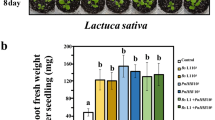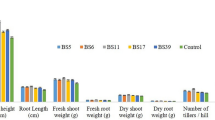Abstract
In this study, the effects of the plant growth-promoting rhizobacterium (PGPR), Bacillus sp. JS on the growth of tobacco (Nicotiana tabacum ‘Xanthi’) and lettuce (Lactuca sativa ‘Crispa’), were evaluated by comparing various growth parameters between plants treated with the bacterium and those exposed to water or nutrient broth as control. In both tobacco and lettuce, fresh weight and length of shoots were increased upon exposure to Bacillus sp. JS. To explain the overall de novo expression of plant proteins by bacterial volatiles, two-dimensional gel electrophoresis was performed on samples from PGPR-treated tobacco plants. Our results showed that chlorophyll a/b binding proteins were significantly up-regulated, and total chlorophyll content was also increased. Our findings indicate the potential benefits of using Bacillus sp. JS as a growth-promoting factor in agricultural practice, and highlight the need for further research to explore these benefits.





Similar content being viewed by others
References
Arnon DI (1949) Copper enzymes in isolated chloroplasts. Polyphenoloxidase in Beta vulgaris. Plant Physiol 24:1–15
Aslantas R, Cakmakcı R, Sahin F (2007) Effect of plant growth promoting rhizobacteria on young apple tree growth and fruit yield under orchard conditions. Sci Hortic 111:371–377
Baldani VLD, Baldani JI, Döbereiner J (2000) Inoculation of rice plants with the endophytic diazatrophs Herbaspirillum seropedicae and Burkholderia spp. Biol Fertil Soils 30:485–491
Bar-Ness E, Hadar Y, Chen Y, Romheld V, Marschner H (1992) Short-term effects of rhizosphere microorganisms on Fe uptake from microbial siderophores by maize and oat. Plant Physiol 100:451–456
Boddey RM, Baldani VLD, Baldani JI, Döbereiner J (1986) Effect of inoculation of Azospirillum spp. on nitrogen accumulation by field-grown wheat. Plant Soil 95:109–121
Boddey RM, Polidoro JC, Resende AS, Alves BJR, Urquiaga S (2001) Use of the 15N natural abundance technique for the quantification of the contribution of N2 fixation to sugar cane and other grasses. Func Plant Biol 28:889–895
Cakmakci R, Kantar F, Sahin F (2001) Effect of N2-fixing bacterial inoculations on yield of sugar beet and barley. J Plant Nutr Soil Sci 164:527–531
Creus CM, Sueldo RJ, Barassi CA (2004) Water relations and yield in Azospirillum-inoculated wheat exposed to drought in the field. Can J Bot 82:273–281
Creus CM, Graziano M, Casanovas EM, Pereyra MA, Simontacchi M, Puntarulo S, Barassi CA, Lamattina L (2005) Nitric oxide is involved in the Azospirillum brasilense-induced lateral root formation in tomato. Planta 221:297–303
Davies PJ (2004) Plant hormones:biosynthesis, signal transduction, action. Kluwer Academic Publishers, Dordrecht
Garcia de Salamone IE, Dobereiner J, Urquiaga S, Boddey RM (1996) Biological nitrogen fixation in Azospirillum strain-maize genotype associations as evaluated by the 15N isotope dilution technique. Biol Fertil Soils 23:249–256
Guo JH, Qi HY, Guo YH, Ge HL, Gong LY, Zhang LX (2004) Biocontrol of tomato wilt by plant growth-promoting rhizobacteria. Biol Control 29:66–72
Gutierrez-Manero FJ, Ramos-Solano B, Probanza A, Mehouachi J, Tadeo FR, Talon M (2001) The plant-growthpromoting rhizobacteria Bacillus pumilus and Bacillus licheniformis produce high amounts of physiologically active gibberellins. Physiol Plant 111:206–211
Hu Y, Schmidhalter U (2005) Drought and salinity: a comparison of their effects on mineral nutrition of plants. J Plant Nutr Soil Sci 168:541–549
James EK, Olivares FL, Baldani JI, Dobereiner J (1997) Herbaspirillum, an endophytic diazotroph colonizing vascular tissue in leaves of Sorghum bicolor L. Moench. J Exp Bot 48:785–797
James EK, Gyaneshwar P, Mathan N, Barraquio QL, Reddy PM, Iannetta PPM, Olivares FL, Ladha JK (2002) Infection and colonization of rice seedlings by the plant growth-promoting bacterium Herbaspirillum seropedicae Z67. Mol Plant-Microbe Interact 15:894–906
Kennedy IR, Tchan YT (1992) Biological nitrogen fixation in non-leguminous field crops: recent advances. In: Ladha JK, George T, Bohlool BB (eds) Biological nitrogen fixation for sustainable agriculture. Springer, Dordrecht, pp 93–118
Khan MS, Almas Z, Javed M (2009) Microbial strategies for crop improvement. Springer, Berlin
Kim ST, Kim HS, Kim HJ, Kim SG, Kang SY, Lim DB, Kang KY (2003) Prefractionation of protein samples for proteome analysis by sodium dodecyl sulfate-polyacrylamide gel electrophoresis. Mole Cell 16:316–322
Kim ST, Kim SG, Hwang DH, Kang SY, Kim HJ, Lee BH, Lee JJ, Kang KY (2004) Proteomic analysis of pathogen-responsive proteins from rice leaves induced by rice blast fungus, Magnaporthe grisea. Proteomics 4:3569–3578
Kim JS, Lee J, Seo SG, Lee C, Woo SY, Kim SH (2015) Gene expression profile affected by volatiles of new plant growth promoting rhizobacteria, Bacillus subtilis strain JS in tobacco. Genes Genom 37:387–397
Kloepper JW, Schroth MN (1978) Plant growth-promoting rhizobacteria on radishes. In Proceedings of the 4th international conference on plant pathogenic bacteria, Gilbert-Clarey, France pp. 879–882
Laemmli UK (1970) Cleavage of structural proteins during the assembly of the head of bacteriophage T4. Nature 227:680–685
Malik KA, Bilal R, Mehnaz S, Rasul G, Mirza MS, Ali S (1997) Association of nitrogen-fixing, plant-growth-promoting rhizobacteria (PGPR) with kallar grass and rice. In: Ladha JK, de Bruijn FJ, Malik KA (eds) Opportunities for biological nitrogen fixation in rice and other non-legumes. Springer, Dordrecht, pp 37–44
Mayak S, Tirosh S, Glick BR (2004) Plant growth promoting bacteria that confer resistance to water stress in tomatoes and peppers. Plant Physiol 166:525–530
Orhan E, Esitken A, Ercisli S, Turan M, Sahin F (2006) Effects of plant growth promoting rhizobacteria (PGPR) on yield, growth and nutrient contents in organically growing raspberry. Sci Hortic 111:38–43
Peer W, Silverthorne J, Peters JL (1996) Developmental and light-regulated expression of individual members of the light-harvesting complex b gene family in Pinus palustris. Plant Physiol 111:627–634
Raj SN, Deepak SA, Basavaraju P, Shetty HS, Reddy MS, Kloepper JW (2003) Comparative performance of formulations of plant growth promoting rhizobacteria in growth promotion and suppression of downy mildew in pearl millet. Crop Prot 22:579–588
Richardson AE (2001) Prospects for using soil microorganisms to improve the acquisition of phosphorus by plants. Aust J Plant Physiol 28:897–906
Ryu CM, Farag MA, Hu CH, Reddy MS, Wei HX, Pare PW, Kloepper JW (2003) Bacterial volatiles promote growth in Arabidopsis. Proc Natl Acad Sci 100:4927–4932
Ryu CM, Farag MA, Hu CH, Reddy MS, Kloepper JW, Paré PW (2004) Bacterial volatiles induce systemic resistance in Arabidopsis. Plant Physiol 134:1017–1026
Sevilla M, Burris RH, Gunapala N, Kennedy C (2001) Comparison of benefit to sugarcane plant growth and 15N2 incorporation following inoculation of sterile plants with Acetobacter diazotrophicus wild-type and Nif—mutant strains. Mol Plant-Microbe Interact 14:358–366
Song JY, Kim HA, Kim JS, Kim SY, Jeong H, Kang SG, Kim BK, Kwon SK, Lee CH, Yu DS, Kim BK, Kim SH, Kwon SY, Kim JF (2012) Genome sequence of the plant growth-promoting rhizobacterium Bacillus sp. Strain JS. J Bacteriol 194:3760–3761
Vessey JK (2003) Plant growth promoting rhizobacteria as biofertilizers. Plant Soil 255:571–586
Yang J, Kloepper JW, Ryu CM (2009) Rhizosphere bacteria help plants tolerate abiotic stress. Trends Plant Sci 14:1–4
Zou C, Li Z, Yu D (2010) Bacillus megaterium strain XTBG34 promotes plant growth by producing 2-pentylfuran. J Microbiol 48:460–466
Acknowledgements
This work was supported by a grant (Code # S211214L030210) from Forest Science & Technology Projects, Forest Service and by Advanced Production Technology Development Program, Ministry of Agriculture, Food and Rural Affairs (Code # 1100345), Republic of Korea.
Author information
Authors and Affiliations
Corresponding author
Ethics declarations
Conflict of interest
Ji Seong Kim declares that he has no conflict of interest. Jeong Eun Lee declares that he has no conflict of interest. Hualin Nie declares that he has no conflict of interest. Yong Jae Lee declares that he has no conflict of interest. Sun Tae Kim declares that he has no conflict of interest. Sun-Hyung Kim declares that he has no conflict of interest.
Ethical approval
This article does not contain any studies with human participants or animals performed by any of the authors.
Rights and permissions
About this article
Cite this article
Kim, J.S., Lee, J.E., Nie, H. et al. Physiological and proteomic analysis of plant growth enhancement by the rhizobacteria Bacillus sp. JS. Genes Genom 40, 129–136 (2018). https://doi.org/10.1007/s13258-017-0615-7
Received:
Accepted:
Published:
Issue Date:
DOI: https://doi.org/10.1007/s13258-017-0615-7




